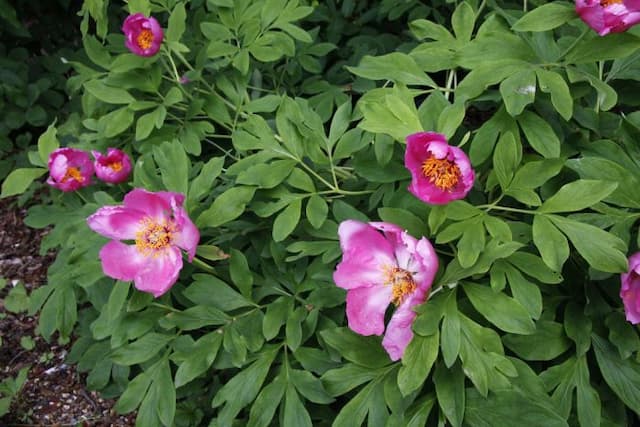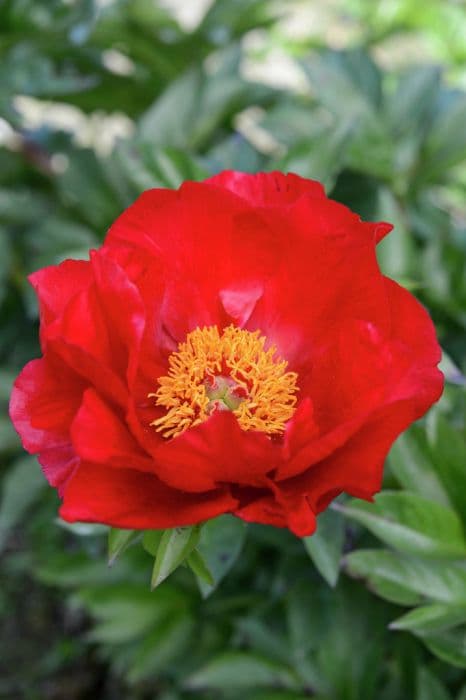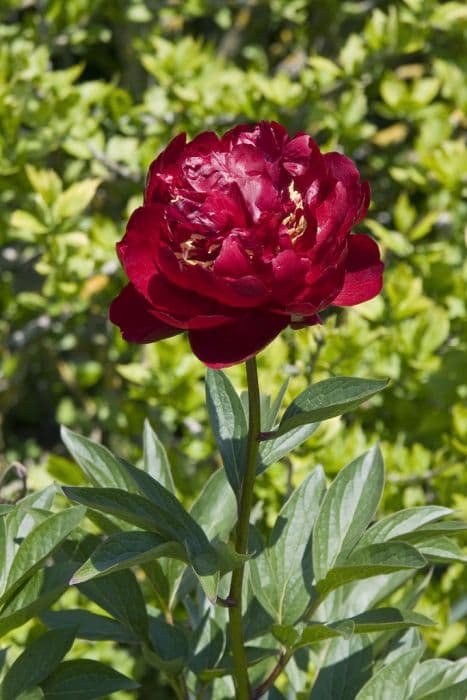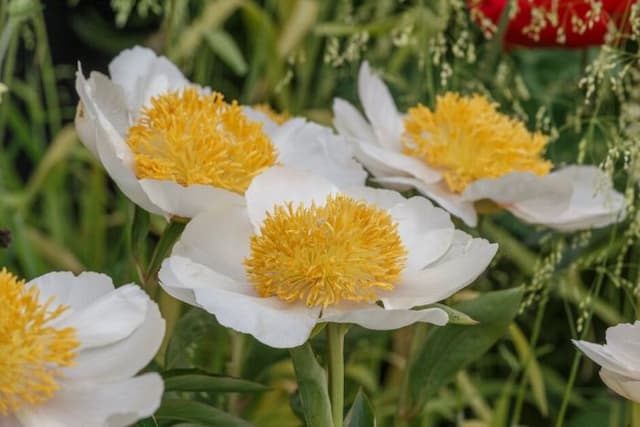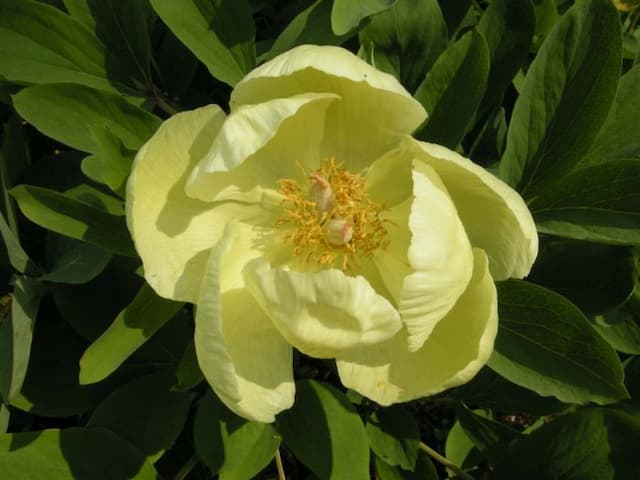Chinese peony Paeonia lactiflora 'Bowl of Beauty'

ABOUT
The plant named 'Bowl of Beauty' is a variety of peony that is known for its distinctive and attractive blossoms. The flowers are large and usually take on a bowl-like form, which is where the name is derived from. An enchanting feature of these blooms is the vivid contrast between the outer petals and the inner fringes. The outer petals are typically a soft, pale pink hue that can be described as pastel or even blush-toned. They are broad and slightly cupped, encircling the center of the flower. At the heart of the bloom, there is a dense puff of frilly, narrow petaloids that usually appear in a creamy or ivory shade. This combination of the delicate pink guard petals and the lighter, fluffy center creates a striking visual effect that's both elegant and bold. Additionally, the plant has dark green foliage that's deeply divided and provides a lush background to the showy flowers, enhancing their visual appeal even further. The foliage and the blooms together create a classic and opulent appearance that makes the 'Bowl of Beauty' a cherished plant in gardens where it adds a romantic touch to the setting. It's particularly popular in ornamental gardens where the aesthetics of flowers are the main focus. The plant tends to bloom in late spring or early summer, offering a delightful display that can attract admirers and pollinators alike.
About this plant
 Names
NamesSynonyms
Chinese Peony, White Peony, Common Garden Peony.
Common names
Paeonia lactiflora 'Bowl of Beauty'.
 Toxicity
ToxicityTo humans
Peony, specifically the Paeonia lactiflora 'Bowl of Beauty', does not have significant toxicity to humans. Ingesting large quantities might cause some stomach upset, but it generally is not considered poisonous. There is no need to worry about severe poisoning symptoms from consuming parts of this plant.
To pets
Peony may cause mild to moderate gastrointestinal upset if ingested by pets such as cats, dogs, or horses. The symptoms of poisoning could include drooling, vomiting, and diarrhea. It is best to prevent pets from eating this plant to avoid these potential consequences. However, the plant does not contain highly toxic compounds that would cause severe poisoning or life-threatening symptoms in pets.
 Characteristics
CharacteristicsLife cycle
Perennials
Foliage type
Deciduous
Color of leaves
Green
Flower color
Pink
Height
2-3 feet (60-90 cm)
Spread
2-3 feet (60-90 cm)
Plant type
Herb
Hardiness zones
3-8
Native area
Asia
Benefits
 General Benefits
General Benefits- Ornamental Value: The Paeonia lactiflora 'Bowl of Beauty', commonly known as Chinese peony, offers stunning blooms that enhance the visual appeal of gardens and landscapes.
- Perennial Growth: As a perennial plant, it returns each year, reducing the need for replanting.
- Scented Flowers: The fragrant flowers provide a pleasant aroma to outdoor spaces when in bloom.
- Attracts Pollinators: Chinese peony flowers attract bees, butterflies, and other beneficial pollinators, supporting local ecosystems.
- Drought Tolerance: Once established, these plants can tolerate periods of low water, making them suitable for drier climates or water-wise gardens.
- Versatility in Landscaping: Can be used in a variety of garden designs, including borders, as specimen plants, or in mass plantings for a dramatic effect.
- Cut Flower Use: The blooms are long-lasting when cut, making them ideal for floral arrangements and bouquets.
 Medical Properties
Medical Properties- Anti-inflammatory: Peony root preparations are traditionally used for their anti-inflammatory effects, especially in traditional Chinese medicine.
- Analgesic: Peony is believed to have pain-relieving properties and may be used to alleviate headaches and body aches.
- Immunomodulatory: Some components in peonies may influence the immune system, potentially supporting immune health.
- Antispasmodic: Peony may be used to help reduce muscle spasms and cramps.
- Menstrual relief: Peony has been used in herbal practice to address menstrual discomfort and regulate menstruation.
- Antioxidant: Like many plants, peony contains antioxidants which may help protect the body from oxidative stress.
- Nervine: Peony may have a calming effect on the nervous system and is sometimes used to aid in conditions such as anxiety or nervous tension.
 Air-purifying Qualities
Air-purifying QualitiesThis plant is not specifically known for air purifying qualities.
 Other Uses
Other Uses- Paeonia lactiflora, commonly known as the Chinese peony, can be used in cut flower arrangements to create vibrant and aromatic displays in homes and at events.
- The petals of the Chinese peony can be used in crafting, as they can be pressed and included in paper making or to decorate homemade cards or bookmarks.
- The large, broad leaves can be incorporated into garden mulch after they die back, contributing nutrients back to the soil and suppressing weeds.
- Dried Chinese peony petals can be used in potpourri mixes, giving a natural and pleasant fragrance to rooms.
- The plant can be grown as part of a butterfly garden, as the flowers are known to attract pollinators such as butterflies and bees.
- The ample foliage provides a green backdrop in floral photography, making it a useful ornamental plant for photographers specializing in plant and garden imagery.
- The Chinese peony can be used in educational settings, such as schools and botanical gardens, to teach about plant biology and horticulture.
- Seeds from the plant can be used for ornamental crafts, like in necklace bead making or as decorative elements in other art projects.
- The plant's blossoms can be used in natural dye making, offering a range of colors from the petals for use in fabric dyeing or art.
- When planted strategically, the Chinese peony can serve as a natural privacy screen in gardens during its peak growing season.
Interesting Facts
 Feng Shui
Feng ShuiThe Peony is not used in Feng Shui practice.
 Zodiac Sign Compitability
Zodiac Sign CompitabilityThe Peony is not used in astrology practice.
 Plant Symbolism
Plant Symbolism- Prosperity: Paeonia lactiflora, commonly known as the peony, often symbolizes prosperity due to its full, rounded blooms that suggest an abundance of wealth.
- Romance and Marriage: With its lush, ruffled petals, the peony is frequently associated with romance and is often used in wedding bouquets and decorations, symbolizing a happy marriage.
- Good Fortune: In many cultures, peonies are considered a good luck charm, representing good fortune and a positive future.
- Beauty and Femininity: The 'Bowl of Beauty' variety, with its attractive form and color, echoes the broader symbolism of peonies concerning grace and feminine beauty.
- Honor and High Value: Due to their status in floral arrangements and the relatively high price for cut blooms, peonies often symbolize honor and the holding of someone or something in high esteem.
- Compassion: Peonies may represent compassion as they have a soothing, gentle appearance that can convey empathy and understanding.
- Bashfulness: In some mythological stories, peonies are linked to bashfulness, possibly because the blooms are seen to hide their beauty within the layers of petals before fully opening.
 Water
WaterPeonies, including the 'Bowl of Beauty', prefer consistent moisture, especially during the growing season. Water the peonies once a week with about 1 inch of water, which is equivalent to about 0.6 gallons per square yard of soil. Ensure the soil is well-draining to avoid soggy conditions, which can lead to root rot. During the hot, dry summer months, watering frequency should increase to keep the soil slightly moist. Reduce watering after the blooming period as the plant prepares for dormancy.
 Light
LightPeonies like 'Bowl of Beauty' thrive in full sun to partial shade environments. The ideal spot would receive at least six hours of direct sunlight daily, which encourages strong stems and abundant blooms. However, in extremely hot climates, dappled afternoon shade can help protect the peonies from excessive heat stress.
 Temperature
Temperature'Bowl of Beauty' peonies are cold-hardy and can withstand winter temperatures as low as -20°F. They grow best in a temperature range of 65°F to 75°F during their growing season. Peonies need a period of winter chill to flower, which means they generally require a minimum of several weeks of temperatures below 40°F to set buds for the following spring.
 Pruning
PruningPeonies like 'Bowl of Beauty' should be pruned to remove spent flowers after blooming to maintain a tidy appearance and prevent seed development, which can take energy away from the plant. In late fall, after the first hard frost, cut back the foliage to near ground level to help control diseases. Pruning is also the time to remove any weak or damaged stems to ensure robust growth for the following season.
 Cleaning
CleaningAs needed
 Soil
SoilThe ideal soil mix for Peony 'Bowl of Beauty' should be well-draining with a neutral to slightly alkaline pH of 6.5 to 7.5. A blend of loamy soil, compost, and perlite or sand to improve drainage is recommended, ensuring the delicate roots do not sit in waterlogged conditions.
 Repotting
RepottingPeony 'Bowl of Beauty' is best repotted infrequently, as they prefer not to be disturbed. Repotting should occur only if the plant outgrows its space, about every 10 to 15 years, or if the soil has become compacted and requires rejuvenation.
 Humidity & Misting
Humidity & MistingPeony 'Bowl of Beauty' thrives in outdoor conditions where the humidity is natural and not too high. They don't require specific humidity levels but do best with good air circulation around the foliage to prevent fungal diseases.
 Suitable locations
Suitable locationsIndoor
Not recommended for indoor growing, needs full sun.
Outdoor
Plant in fertile, well-drained soil in full sun.
Hardiness zone
3-8 USDA
 Life cycle
Life cyclePaeonia lactiflora 'Bowl of Beauty', commonly known as the Chinese peony, begins its cycle in early spring when red shoots emerge from the soil. These shoots quickly develop into large green foliage with deep incisions. By late spring, large buds form at the tips of the stems and eventually unfurl into fragrant, bowl-shaped flowers, with pink petals surrounding a center of cream or yellow petaloids. After blossoming, usually in late spring to early summer, the flowers last up to 10 days before the petals drop, and the plant then sets seed in the form of a capsule if pollination has occurred. In summer, the foliage remains as an attractive bush, providing a backdrop for other plants. As autumn approaches, the leaves begin to yellow and wilt before the plant becomes dormant in winter, retreating back to the ground level until the next growing season.
 Propogation
PropogationPropogation time
Early fall
The Paeonia lactiflora 'Bowl of Beauty', commonly known as the peony, is typically propagated through division. The best time to propagate peonies is in the fall, when the plants have become dormant. To propagate by division, you should carefully dig up the peony plant, ensuring you take as much of the root system as possible. The root ball should then be divided into sections, each with at least 3 to 5 eyes—these are the small reddish buds on the crown of the root. The divisions can then be planted in well-draining soil with the eyes positioned about 1 to 2 inches below the soil surface (2.5 to 5 centimeters). It's essential to avoid planting too deep as this can prevent the peony from blooming. After planting, the divisions should be watered thoroughly and allowed to settle in before the onset of winter.
